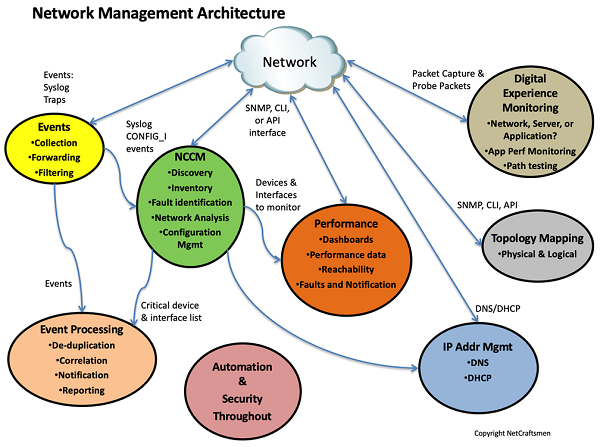A big network is a complex system that generates a very large volume of data: log messages, network state data, device state data, device configurations, interface performance data, and application performance data. Manually collecting and analyzing all this data is impossible. Network management tools provide basic support for data collection, analysis, and reporting, ideally converting it into actionable information that can be used to identify and correct network problems.
Technologists are constantly looking for the network management station (NMS) product that provides the holy grail of network management: a single pane of glass and a one-button solution. As a result, business managers get frequent requests to purchase some new tool that they don’t know anything about, and they eventually develop a reluctance to support the suite of tools needed for network management. An analysis can help both parties understand what’s required and get a handle on the expected costs. A search for “cost of network management” found
one relevant article from 2018 directed at small businesses with 25 devices.
A Network Management Architecture
Comprehensive network management requires different tools that perform very different functions, making the single solution product (the single pane of glass) very difficult to achieve. It helps to view it as a system architecture comprised of multiple functions, as shown below.
Events and event processing handle syslog, SNMP traps, and logging in general. The volume can be large, so event processing is needed to turn the raw data into useful information. Network change and configuration management (NCCM) support managing network device configurations. Performance collects and analyzes network performance data to identify errors and bottlenecks. IP address management aids in managing the network address space. Topology provides visibility into physical and logical connectivity.
Digital experience monitoring identifies endpoint and application performance problems. It often includes logical topology mapping between test points. Automation and security have to be incorporated across the entire infrastructure. Refer to my article “
A Network Management Architecture” for more details on each of these functions.
Each function is very different from the others and results in solutions dedicated to each function. When a product covers multiple functions, you’ll frequently encounter licensing costs and poor integration for each function. This is what makes a single pane of glass solution difficult to achieve. The best solution is to create a custom dashboard that pulls information from each product to provide operational visibility. You should use the architecture to determine what functions your NMS tool suite provides and to identify holes.
Why the High Cost?
So, why does network management cost so much? One factor is that organizations often buy only one copy. Vendors spend a lot of time and effort building and maintaining an NMS product. They need to recover the cost of their engineering time and make a profit. Contrast that with a hardware vendor who may sell a box that costs a small fraction of what the NMS costs but sells multiple boxes to each customer.
Another factor is the diverse set of requirements for each function in the architecture. Very successful companies have been built to satisfy a single function (e.g., Splunk for event management or Infoblox for IP address management).
Multiple network management products also drives up staffing and training costs. You need at least two experts on each product’s operation in order to avoid getting in a jam if or when something happens when an expert is on vacation.
It helps to find products that don’t require a lot of work to install or constant fiddling to keep running. Many NMS products are delivered as a toolkit, not a turn-key solution. Make sure your staff is prepared for the type of products you’re installing.
Cost Reduction Steps
The good news is that careful choice of products can help hold down the cost. Here are some tips on choosing wisely.
Carefully analyze the functionality of new products and avoid duplication. You may find that custom development of an interface between products solves a problem that seemed to require a separate product.
Select products that are easy to install and maintain. Many NMS solutions are really toolkits that require consulting expertise to set up and operate, adding to their implementation cost.
You can often choose between an on-premises solution or a cloud-based solution. Cloud implementations are frequently less expensive to set up and operate. The vendor maintains the NMS solution. There will often be an on-premises data collection system, likely delivered as a virtual machine image that’s easy to install.
Managed service providers (MSPs) are another alternative. The MSP amortizes the management system and staffing costs over multiple customers. Make sure that the products properly support multi-tenancy so that your data isn’t co-mingled with that of other customers. You can benefit from the lower cost of the products and much lower personnel expenses. Pricing is often per managed device and varies according to the number of functions being performed. Pricing may be by a managed entity, which can be per interface or CPU, so check carefully.
An alternative to the MSP is to hire consultants to set up your system while you staff the operational aspects. Find consultants who will help train your staff during the installation and configuration process and who demonstrate good documentation practices.
A Rule of Thumb
Is there a generally accepted figure for how much network management should cost? One article by Cisco long ago (no longer retrievable) suggested ten percent per year of the annual hardware cost. An annual networking hardware budget of $1M would imply an additional $100K per year for the NMS. This is a good starting point for your NMS budget.
Beware of acquiring a product that doesn’t cover all of your network infrastructures because it’s too expensive to fully deploy. The best example was a customer whose applications were experiencing performance problems. We found that only network infrastructure links were monitored, not network interfaces that connected to servers. There was significant packet loss on the switch interfaces that hosted their main production servers, resulting in poor application performance. It’s always advisable to monitor all active network interfaces (i.e. any interface that’s in the Up-Up state) for a variety of performance and error statistics.
The network management space includes a wide range of product price points and functionality. There are products and open source projects to fit every budget while providing the network visibility that’s required for the functions of a comprehensive network management architecture.











